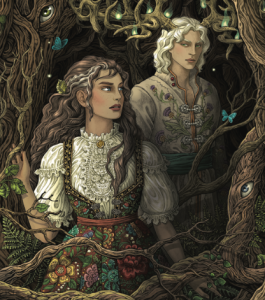
February 2024 Stars & Big Picture
Starred titles are books of special distinction. See the archives for selections from previous months.
Becker, Aaron The Last Zookeeper; written and illus. by Aaron Becker. Candlewick, 2024 [40p]
Trade ed. ISBN 9781536227680 $18.99
Reviewed from digital galleys R* 6-9 yrs
Engle, Margarita Wild Dreamers. Atheneum, 2024 [224p]
Trade ed. ISBN 9781665939751 $18.99
E-book ed. ISBN 9781665939775 $10.99
Reviewed from digital galleys R* Gr. 8-11
Min, Cat The Shadow and the Ghost; written and illus. by Cat Min. Levine Querido, 2024 [48p]
Trade ed. ISBN 9781646143689 $18.99
Reviewed from digital galleys R* 4-7 yrs
Poranek, A.B. Where the Dark Stands Still. McElderry, 2024 [368p]
Trade ed. ISBN 9781665936477 $19.99
E-book ed. ISBN 9781665936491 $10.99
Reviewed from digital galleys R* Gr. 8-12
See this month’s Big Picture for review.
Randall, Christen The No-Girlfriend Rule. Atheneum, 2024 [336p]
Trade ed. ISBN 9781665939812 $19.99
E-book ed. ISBN 9781665939836 $10.99
Reviewed from digital galleys R* Gr. 7-12
Ukazu, Ngozi Bunt! Striking Out on Financial Aid; illus. by Mad Rupert. First Second, 2024 [288p]
Trade ed. ISBN 9781250193520 $25.99
Paper ed. ISBN 9781250193513 $17.99
Reviewed from digital galleys R* Gr. 10-12
Underhill, Edward This Day Changes Everything. Wednesday/St. Martin’s, 2024 [288p]
Trade ed. ISBN 9781250835222 $20.00
E-book ed. ISBN 9781250835239 $11.99
Reviewed from digital galleys R* Gr. 8-12
Yang, Gene Luen Lunar New Year Love Story; illus. by LeUyen Pham. First Second, 2024 [352p]
Trade ed. ISBN 9781626728103 $25.99
Paper ed. ISBN 9781250908261 $17.99
E-book ed. ISBN 9781250365903 $11.99
Reviewed from digital galleys R* Gr. 9-12
 Where the Dark Stands Still
Where the Dark Stands Still
By A.B. Poranek
The premise of this month’s Big Picture is a bit like Beauty & the Beast meeting Howl’s Moving Castle to tell a beautifully written story of self-acceptance, sacrifice, and forgiveness. With echoes of Eastern European folklore, the fairy tale beats are immediately recognizable: a clever girl shunned from her community, a terrifying but possibly misunderstood monster, a bargain that brings them together in an enchanted wood. Poranek, like fantasy author Robin McKinley, elevates the familiar narrative through poetic symbolism, fully developed characters, and a skillful balance of darkness and whimsy.
Driven to the Driada woods in search of a wish-granting flower, Liska instead finds herself at the mercy of the Driada’s notorious warden, a demon known as the Leszy. The demon offers Liska a bargain: if she serves him for a year, he will grant her wish to be free of her innate but untrained magic. Liska has lost much to her magic, including her best friend, and she’s been ostracized by the people in her village, with even her own mother fearing Liska’s power. Wracked by guilt and wanting only to belong in her own community, she accepts the Leszy’s bargain and begins her new life in his enchanted and strangely sentient manor, the House Under the Rowan Tree. Try as she might, Liska can’t ignore her magic entirely, as it allows her to see and make friends with an acerbic and arch house-spirit and a fearsome ghost hound, while the house itself endeavors to help Liska uncover the mysteries of the Leszy’s past. Perhaps by unlocking his secrets she can discover his true purpose as well as her own.
Poranek expertly draws on fairy tale conventions around appearance and deception to make the world itself a character, creating spaces readers will grow to love as gradually as Liska. Poetic imagery breathes life into the story’s environs: in the oppressive atmosphere of the Driada, “a tree is not a tree but a disfigured body with crooked limbs.” The Leszy’s home is given a Gothic grandeur: “Even veiled in cobwebs and dust, the manor clings to a former magnificence, like an old woman recalling the vigorous days of her youth.” Clever metaphors and vivid similes hint at a world unseen, giving, for example, an early glimpse of the manor’s personality when the dust greets Liska’s arrival by “ris[ing] in spirals and whorls, brushing against Liska like an over-affectionate cat.” For all the melancholy and foreboding trappings, there is comfort here, too.
Close third-person present narration evokes the drama of the oral storytelling tradition and yet still brings an intimacy that allows readers to readily identify with Liska’s desperate struggle to accept parts of herself that others have rejected or feared. While her magic does not represent a specific real-world allegory, the themes of trauma and otherness give Liska’s struggles a painful relatability. Liska’s desire to rid herself of her magic is poignant and heart-rending, as “she digs her fingers into her chest, over her heart, as if she could claw it out.” As Liska gets to know the Leszy as a person, rather than the nightmare she’s been told he is, her compassion for him allows her to extend compassion to herself. Upon discovering the Leszy’s true mission, to protect the humans from the monsters of the Driada, she learns to embrace her power and her own duality: she is capable of protection as well as harm.
This is a bittersweet and timeless tale, and its ultimate message is as applicable in shadowy fairy tale forests as it is in the halls of school and beyond. The desire for belonging is overwhelmingly strong and can so easily make difference seem like a threat. Teens finding themselves on the outside looking in will appreciate the Leszy’s advice to Liska: “If the world has not prepared a place for you, you must take up a hammer and chisel and carve one out for yourself.”
—Aaren Tucker, Reviewer
Cover illustration from Where the Dark Stands Still copyright © 2024 Magdalena Kaczan. Reproduced by permission of the publisher, Simon & Schuster.

